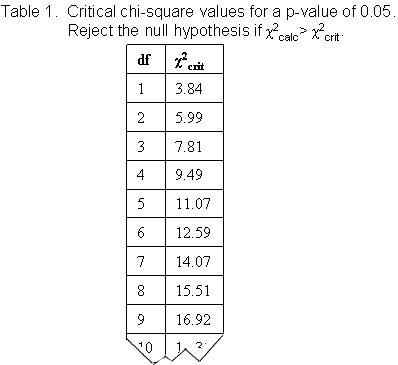Spock's Ears
One commercial break and several hundred computer searches later, Bones had assembled data on reproductive patterns in heterozygote Vulcans and Yodites (i.e., EPep x EPep crosses, where E and e are ear shape, and P and p are psionic power), with the following results:
| Vulcans | Yodites | |
|---|---|---|
| pointy (E), psionic (P) |
122 | 104 |
| pointy (E) , non-psionic (p) |
21 | 8 |
| rounded (e), psionic ( P) |
20 | 20 |
| rounded (e), non-psionic (p) |
37 | 18 |
"Great!" enthused Kirk again, rubbing his hands. "Let's start with the Vulcans. What do we do next?"
"Well, captain, first we need to check that each that each gene is acting according to normal rules in each species"
 "Normal rules? What, do you expect them to be out partying?"
"Normal rules? What, do you expect them to be out partying?"
Bones sighed. "No, but normally if a gene is dominant, three-quarters of the offspring of a heterozygote cross should exhibit the dominant phenotype, while one-quarter should exhibit the recessive genotype. That's what we need to test for. You following me?"
"Uh ... sure."
"Alright then. Let's see, I get 143 pointy-eared vulcans and 57 round-eared vulcans. That looks like about a 3 to 1 ratio. Better do a chi-square test to make sure:
(Below, you fill in the observed and expected values, and click "finish the test..." to get the final answer).
"You still awake there, captain? How about you do the test for psionic vs. non-psionic powers...
| observed ("o") | expected ("e") | (o-e) | (o-e)2 | (o-e)2/e | |
psionic |
142 | 150 | -8 | 64 | .43 |
non-psionic |
58 | 50 | 8 | 64 | 1.28 |
| Total | 200 | 200 |
1.71
|
"Well," continued Bones, "it looks like the gene for pointy ears does assort randomly in Vulcans. And so does the gene for psionic powers."
 "So we're done, then?" asked Kirk hopefully.
"So we're done, then?" asked Kirk hopefully.
"No, that was just setting the stage. Now that we know each gene acts normally on its own, we can predict what they should do together, assuming they're not linked."
"Wait, shouldn't we assume they are linked? I mean, aren't you going about this backwards?"
"No, Jim. If we assumed they are linked, we wouldn't know how closely linked they are. So we couldn't make any hard-and-fast predictions and then we wouldn't be able to do any statistics, and that would be a shame."
"Hmm," murmured Kirk.
"Glad you agree. Now we need to see whether the ratios of the four phenotypes fit the famous Double Hybrid ratio. Remember that one?"
"You mean the 9:3:3:1 ratio?"
"Yup, that's the one. Does it look like the phenotypes fit that ratio?"
"Well, 9:3:3:1 would mean that there are a lot of the homozygous dominant phenotype, and only a few of the homozygous recessive, and an intermediate number of the others. No, that doesn't seem like what's going on. Actually there are more rounded-eared non-psionic vulcans running around than there should be."
"I agree. So, go ahead and set up that test -- if you can disprove the 9:3:3:1 ratio, that's the clincher."
| group | o | e | o-e | (o-e)2 | (o-e)2/e |
| pointy (E), psionic (P) |
122 | 112.5 | 9.5 | 90.25 | 0.80 |
| pointy (E) , non-psionic (p) |
21 | 37.5 | -16.5 | 272.25 | 7.26 |
| rounded (e), psionic ( P) |
20 | 37.5 | -17.5 | 306.25 | 8.17 |
| rounded (e), non-psionic (p) |
37 | 12.5 | 24.5 | 600.25 | 48.2 |
| Total | 200 | 200 | 64.25 |
"Very interesting... Or as Spock would say, fascinating." What did this final test reveal?
Copyright University of Maryland, 2007
You may link to this site for educational purposes.
Please do not copy without permission
requests/questions/feedback email: mathbench@umd.edu